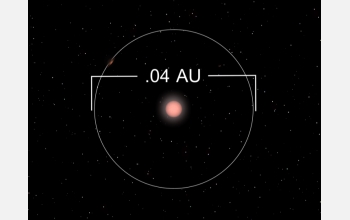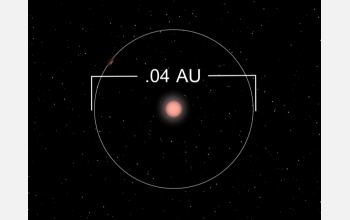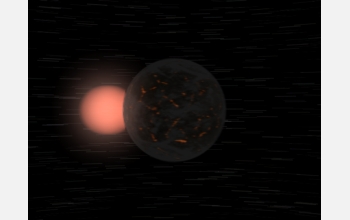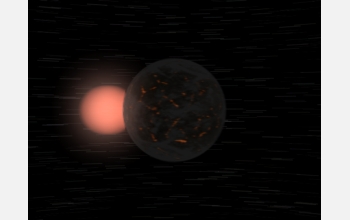All Images
News Release 05-097
Astronomers Announce the Most Earth-Like Planet Yet Found Outside the Solar System
This material is available primarily for archival purposes. Telephone numbers or other contact information may be out of date; please see current contact information at media contacts.

In this artist's conception, the newly discovered planet is shown as a hot, rocky, geologically active world glowing in the deep red light of its nearby parent star, the M dwarf Gliese 876. The heat and the reddish light are among the few things about the new planet that are certain; depending on the thickness and composition of its atmosphere - if any - it could range from being a barren, cratered ball of rock like Mercury or the Moon, to being a featureless, cloud-shrouded cue-ball like Venus.
Credit: Trent Schindler, National Science Foundation
Download the high-resolution JPG version of the image. (1.9 MB)
Use your mouse to right-click (Mac users may need to Ctrl-click) the link above and choose the option that will save the file or target to your computer.

View Video
With Michael Turner (far right), head of NSF's Directorate of Mathematical and Physical Sciences, as moderator, members of the research team (from right to left, Geoffrey Marcy of the University of California, Berkeley, Paul Butler of the Carnegie Institution of Washington, Eugenio Rivera of the Lick Observatory, University of California, Santa Cruz, and theoretical astronomer Jack Lissauer of NASA's Ames Research Center) presented their findings during a press conference on Monday, June 13, 2005, at NSF in Arlington, Va.
For more about the webcast, see http://www.nsf.gov/news/newsmedia/planet05/index.jsp
Credit: Patrick Olmert, National Science Foundation

View Video
This animation shows the newly discovered planet and its two larger siblings as they orbit the M dwarf star Gliese 876. The star and the orbits are to scale; the planet sizes are exaggerated. In addition, the orbits are shown inclined at an angle of 50 degrees, which is how they appear in our sky.
The outermost planet, known as Gliese 876b, was discovered in 1998. It orbits the star once every 61 Earth days, and has about twice the mass of Jupiter, our own solar system's largest planet. That makes it roughly 600 times the mass of the Earth. The middle planet, Gliese 876c, was discovered in 2001. It orbits the star once every 30 days and has about half the mass of Jupiter, or roughly 150 times the mass of the Earth.
The new planet has about twice the radius of the Earth and about seven-and-a-half times its mass, and orbits the star once every two days.
Credit: Trent Schindler, National Science Foundation

View Video
Broadcast quality, 29.97 frames per second, 720x486 resolution, non-square pixels, file size 24Mb
Credit: Trent Schindler, National Science Foundation

View Video
This animation takes us on a flythrough of the Gliese 876 system. The star, the orbits and the sizes of all three known planets are to scale.
We first see the outermost planet, Gliese 876b, which was discovered in 1998. It orbits the star once every 61 Earth days, and has about twice the mass of Jupiter, our own solar system's largest planet. That makes it roughly 600 times the mass of the Earth. Next we see the middle planet, Gliese 876c, which was discovered in 2001. It orbits the star once every 30 days and has about half the mass of Jupiter, or roughly 150 times the mass of the Earth.
Finally we come to the newly discovered planet. It has about twice the radius of the Earth and about seven-and-a-half times its mass, and it orbits the star once every two days.
Credit: Trent Schindler, National Science Foundation

View Video
Broadcast quality, 29.97 frames per second, 720x486 resolution, non-square pixels, file size 21Mb
Credit: Trent Schindler, National Science Foundation

These three graphs show the observational data and the best theoretical fit for each of the three planets known to orbit the star Gliese 876. From top to bottom the panels are for the newly discovered planet, the middle planet and the outermost planet. The vertical axes (which are different for each) refer to the tiny back-and-forth motions the orbiting planets cause in their parent star. The colors refer to the year the observations were made. The wide variations seen in the second panel reflect the strong gravitational perturbations the planets exert on one another.
Credit: Eugenio Rivera et al.
Download the high-resolution JPG version of the image. (376 KB)
Use your mouse to right-click (Mac users may need to Ctrl-click) the link above and choose the option that will save the file or target to your computer.


